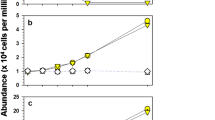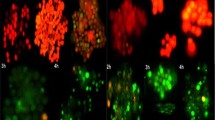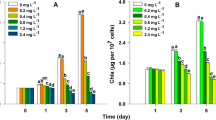Abstract
Oleamide, a fatty acid derivative, shows inhibitory effect against the bloom-forming cyanobacterium Microcystis aeruginosa. The EC50 of oleamide on the growth of M. aeruginosa NIES-843 was 8.60 ± 1.20 mg/L. In order to elucidate the possible mechanism of toxicity of oleamide against M. aeruginosa, chlorophyll fluorescence transient, cellular ultrastructure, fatty acids composition and the transcription of the mcyB gene involved in microcystins synthesis were studied. The results of chlorophyll fluorescence transient showed that oleamide could destruct the electron accepting side of the photosystem II of M. aeruginosa NIES-843. Cellular ultrastructure examination indicated that the destruction of fatty acid constituents, the distortion of thylakoid membrane and the loss of integrity of cell membrane were associated with oleamide treatment and concentration. The damage of cellular membrane increased the release of microcystins from intact cells into the medium. Results presented in this study provide new information on the possible mechanisms involved and potential utilization of oleamide as an algicide in cyanobacterial bloom control.






Similar content being viewed by others
References
Akanmu MA, Adesun SO, Ilesanmi OR (2007) Neuropharmacological effects of oleamide in male and female mice. Behav Brain Res 182:88–94
Appenroth KJ, Stöckel J, Srivastava A, Strasser RJ (2001) Multiple effects of chromate on the photosynthetic apparatus of Spirodela polyrhiza as probed by OJIP chlorophyll a fluorescence measurements. Environ Pollut 115:49–64
Boger DL, Patterson JE, Guan X, Cravatt BF, Lerner RA, Gilula NB (1998) Chemical requirements for inhibition of gap junction communication by the biologically active lipid oleamide. Proc Natl Acad Sci USA 95:4810–4815
Christen D, SchÖnmann S, Jermini M, Strasser RJ, Défago G (2007) Characterization and early detection of grapevine (Vitis vinifera) stress responses to esca disease by in situ chlorophyll fluorescence and comparison with drought stress. Environ Exp Bot 60:504–514
Cravatt BF, Prospero-Garcia O, Siuzdak G, Gilula NB, Henriksen SJ, Boger DL, Lerner RA (1995) Chemical characterization of a family of brain lipids that induce sleep. Science 268:1506–1509
Dittmann E, Wiegand C (2006) Cyanobacterial toxins—occurrence, biosynthesis and impact on human affairs. Mol Nutr Food Res 50:7–17
El-Moez SIA, Abdelmonem MA, Gomaa AM, Aziz MFA (2013) In vitro antibacterial activities of dietary medicinal ethanolic extracts against pathogenic reference strains of animal origin. Afr J Microbiol Res 7:5261–5270
Farrell EK, Chen Y, Barazanji M, Jeffries KA, Cameroamortegui F, Merkler DJ (2012) Primary fatty acid amide metabolism: conversion of fatty acids and an ethanolamine in N18TG2 and SCP cells. J Lipid Res 53:247–256
Ichimura T (1979) Media for freshwater cyanobacteria. In: Nishizawa K, Chihara M (eds) Methods in phycology. Kyouritsu Shuppan, Tokyo, pp 295–296
Jančula D, Gregorova J, Maršálek B (2010) Algicidal and cyanocidal effects of selected isoquinoline alkaloids. Aquac Res 41:598–601
Juttner F, Luthi H (2008) Topology and enhanced toxicity of bound microcystins in Microcystis PCC 7806. Toxicon 51:388–397
Kabara JJ, Swieczkowski DM, Conley AJ, Truant JP (1972) Fatty acids and derivatives as antimicrobial agents. Antimicrob Agents Chemother 2:23–28
Kasemets K, Kahru A, Laht TM, Paalme T (2006) Study of the toxic effect of short and medium-chain monocarboxylic acids on the growth of Saccharomyces cerevisiae using the CO2-auxo-accelerostat fermentation system. Int J Food Microbiol 111:206–215
Kim SC, Chapman KD, Blancaflor EB (2010) Fatty acid amide lipid mediators in plants. Plant Sci 178:411–419
Kurmayer R, Kutzenberger T (2003) Application of real-time PCR for quantification of microcystin genotypes in a population of the toxic cyanobacterium Microcystis sp. Appl Environ Microbiol 69:6723–6730
Li FM, Hu HY (2005) Isolation and characterization of a novel antialgal allelochemical from Phragmites communis. Appl Environ Microbiol 71:6545–6553
Lu Y, Zhou Y, Nakai S, Hosomi M, Zhang H, Kronzucker HJ, Shi W (2014) Stimulation of nitrogen removal in the rhizosphere of aquatic duckweed by root exudate components. Planta 239:591–603
Müeller SO, Lutz WK, Stopper H (1998) Factors affecting the genotoxic potency ranking of natural anthraquinones in mammalian cell culture systems. Mutat Res 414:125–129
Nakai S, Inoue Y, Hosomi M, Murakami A (2000) Myriophyllum spicatum-releasing allelopathic polyphenols inhibiting growth blue-green algae Microcystis aeruginosa. Water Res 34:3026–3032
Nakai S, Yamada S, Hosomi M (2005) Anti-cyanobacterial fatty acids released from Myriophyllum spicatum. Hydrobiologia 543:71–78
Nanayakkara NP, Schrader KK (2008) Synthesis of water-soluble 9,10-anthraquinone analogues with potent cyanobactericidal activity toward the musty-odor cyanobacterium Oscillatoria perornata. J Agric Food Chem 56:1002–1007
Ozaki K, Ito E, Tanabe S, Natsume K, Tsuji K, Harada K (2009) Electron microscopic study on lysis of a cyanobacterium Microcystis. J Health Sci 55:578–585
Shao J, Wu Z, Yu G, Peng X, Li R (2009) Allelopathic mechanism of pyrogallol to Microcystis aeruginosa PCC7806 (Cyanobacteria): from views of gene expression and antioxidant system. Chemosphere 75:924–928
Shao J, Xu Y, Wang Z, Jiang Y, Yu G, Peng X, Li R (2011) Elucidating the toxicity targets of β-ionone on photosynthetic system of Microcystis aeruginosa NIES-843 (Cyanobacteria). Aquat Toxicol 104:48–55
Shao J, Li R, Lepo JE, Gu J-D (2013a) Potential for control of harmful cyanobacterial blooms using biologically derived substances: problems and prospects. J Environ Manage 125:149–155
Shao J, Liu D, Gong D, Zeng Q, Yan Z, Gu J-D (2013b) Inhibitory effects of sanguinarine against the cyanobacterium Microcystis aeruginosa NIES-843 and possible mechanisms of action. Aquat Toxicol 142–143:257–263
Stevens S, Hofemyer JHS (1993) Effects of ethanol, octanoic and decanoic acids on fermentation and the passive influx of protons through the plasma membrane of Saccharomyces cerevisiae. Appl Microbiol and Biotech 38:656–663
Strasser BJ, Strasser RJ (1995) Measuring fast fluorescence transients to address environmental questions: the JIP test. In: Mathis P (ed) Photosynthesis: from light to biosphere, vol 5. Kluwer Academic, Netherlands, pp 977–980
Strasser RJ, Srivastava A, Govindjee (1995) Polyphasic chlorophyll a fluorescence transient in plants and cyanobacteria. Photochem Photobiol 61:32–42
Teaster ND, Motes CM, Tang Y, Wiant WC, Cotter MQ, Wang YS, Kilaru A, Venables BJ, Hasenstein KH, Gonzalez G, Blancaflor B, Chapman KD (2007) N-acylethanolamine metabolism interacts with abscisic acid signaling in Arabidopsis thaliana seedlings. Plant Cell 19:2454–2469
Tripathy S, Venables BJ, Chapman KD (1999) N-acylethanolamines in signal transduction of elicitor perception. Attenuation of alkalinization response and activation of defense gene expression. Plant Physiol 121:1299–1308
Wang W (2000) Determination of chlorophyll. In: Li HS (ed) Principles and methods for the physiological and biochemical experiments of plant. Higher Education Press, Beijing, pp 134–137
Wang HQ, Wu ZB, Zhang SH, Cheng SP, He F, Liang W (2008) Relationship between the allelopathic activity and molecular structure of hydroxyl derivatives of benzoic acid and their effects on cyanobacterium Microcystis aeruginosa. Allelopath J 22:205–212
Wu JT, Chiang YR, Huang WY, Jane WN (2006) Cytotoxic effects of free fatty acids on phytoplankton algae and cyanobacteria. Aquat Toxicol 80:338–345
Wu TT, Charles AL, Huang TC (2007) Determination of the contents of the main biochemical compounds of Adlay (Coxi lachrymal-jobi). Food Chem 104:1509–1515
Wu Y, Liu J, Yang L, Chen H, Zhang S, Zhao H, Zhang N (2011) Allelopathic control of cyanobacterial blooms by periphyton biofilms. Environ Microbiol 13:604–615
Acknowledgments
The research was supported by National Natural Science Foundation of China (No. 31,470,511).
Conflict of interest
Authors have no conflict of interest on the research results reported here. This article does not contain any studies with human participants or animals performed by any of the authors.
Author information
Authors and Affiliations
Corresponding author
Rights and permissions
About this article
Cite this article
Shao, J., He, Y., Li, F. et al. Growth inhibition and possible mechanism of oleamide against the toxin-producing cyanobacterium Microcystis aeruginosa NIES-843. Ecotoxicology 25, 225–233 (2016). https://doi.org/10.1007/s10646-015-1582-x
Accepted:
Published:
Issue Date:
DOI: https://doi.org/10.1007/s10646-015-1582-x




